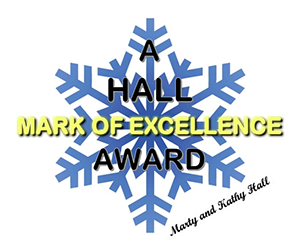 This World Cup coverage is made possible through the generous support of Marty and Kathy Hall and A Hall Mark of Excellence Award. To learn more about A Hall Mark of Excellence Award, or to learn how you can support FasterSkier’s coverage, please contact info@fasterskier.com.
This World Cup coverage is made possible through the generous support of Marty and Kathy Hall and A Hall Mark of Excellence Award. To learn more about A Hall Mark of Excellence Award, or to learn how you can support FasterSkier’s coverage, please contact info@fasterskier.com.

In the third week of World Cup racing, the defining question seemed to be not who would be first to the finish line, but who was missing from the starting line.
In the Friday’s sprints, Johannes Hoesflot Klaebo’s (illness) and Federico Pellegrino (fatigue) were both absent. That change to the startlist saw a chaotic and tense affair translate to new, and newfound, highs for Italy’s Simone Mocellini and Sweden’s Calle Halfvarsson. On Saturday, Iivo Niskanen’s absence from the 10 k classic field created an opening (after five long years) for Andrew Musgrave’s (GBR) return to the podium.
In Sunday’s Team Relay, though the notable absences were in the American lineup…
US Team Makes Tough Decision on Relay Lineup
US Ski Team Head Coach, Matt Whitcomb delivered the news to FasterSkier that Jessie Diggins and Rosie Brennan would not start in Sunday’s relays, undoing the female half of last season’s 4 x 5 k – winning US relay team that won at World Cup Finals. Both Diggins and Brennan have been vocal about team events like the relay being their favorite part of racing on the World Cup, and the event has been a point of emphasis in previous World Cup seasons.
“It feels weird to say I support this as a coach,” said Whitcomb on the decision to take Diggins and Brennan out of a team event. “But we’ve now been doing this long enough to know that an athlete just cannot sustain the full schedule of [the World Cup]. There are traps that are set for them along the way, and this relay just is one of them. It falls at a time when they really need to rest.”
For Brennan, the absence was primarily a matter of health, with Whitcomb adding, “We were lucky to get two good days of racing after she was sick in Lillehammer. We feel like we might be getting ahead of ourselves if we try to put a third together.”
For Diggins, the stress of having started all eight World Cup races so far this season—combined with the new World Cup scoring system—preceded the decision not to race today. “One of the interesting dynamics of the new World Cup scoring this year is that there are no individual points scored for relays, like there has been in the past,” said Whitcomb. “When it comes to chasing the Overall [World Cup Title] (something Diggins identified as a goal in preseason talks with the media) the relay doesn’t add to the pile.”
In place of Diggins and Brennan, the announced teams for the US turned towards the young generation of skiers who have accompanied the veteran stars of US skiing the past few seasons. The US announced two relay teams Sunday morning:
USA I: Classic Leg 1 – Julia Kern, Classic Leg 2 – Hunter Wonders, Skate Leg 1 – Sophia Laukli, Skate Leg 2 – Ben Ogden.
USA II: Classic Leg 1 – Alayna Sonnesyn, Classic Leg 2 – Zak Ketterson, Skate Leg 1 – Novie McCabe, Skate Leg 2 – Gus Schumacher.
Once teams were announced, however, the theme of rest came back into play. At the end of a third consecutive three-day weekend of racing in Period I, the unique demands on the US Ski Team—traveling continents to compete against nation’s with plenty of skiers to reinforce their World Cup squads close at hand—precipitated the decision to scratch USA II, and see the US start only its USA I team.
The USA I team that did race looked forward to a 4 x 5 k format that has been pioneered at Junior World Championships the past few seasons. US anchor Ben Ogden said to FasterSkier that the 5 k “makes for an interesting race because it’s short enough where if you’re feeling good you can hang with skiers much better than you. I think for the US team this new format is really exciting because on the right day we can be right there with the top dogs even if we are not all fighting for the podium every other day.”
Still, there was some trepidation in the US camp about choosing to strategically re-charge on the day. “[Emotionally] this is tough, because we’ve built our program around [team events like today],” said Whitcomb. “[Team events] are an important metric that speak beyond just who is getting on the podium or in the top 30. It’s a sign of a healthy [national] program when you do well in a [team] event” said Whitcomb.
The Race
By the metric of team success, all signs still point toward cross country skiing being alive and well in Norway, but the finishing order that Norwegian coaches might have envisioned was not the way the script played out on the rolling 2.5 k course (on which each athlete skied two laps): Norway II would finish first on the day, followed by Norway I and Sweden I.
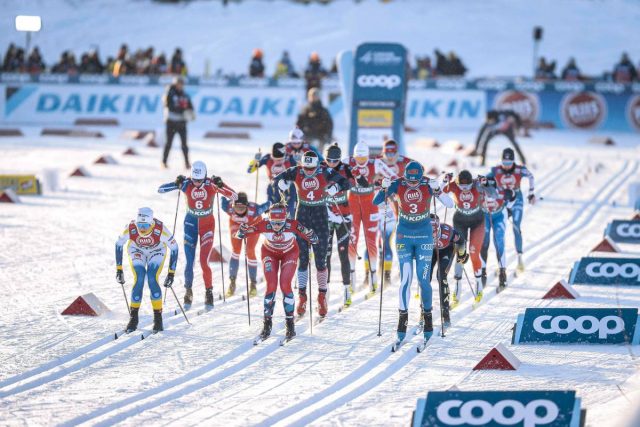
Moments of clarity eluded today’s race—a push by one skier over one hill, an uptick of tempo by another as they exited the stadium—but those efforts regularly vanished like frozen crystals in the cold Beitostolen air. In the final lap of the final leg, however, a push by Simen Hegstad Krueger finally turned into something real. As the course ticked up, Krueger pushed away from a pack including Norway I teammate, Emil Iversen, and Sweden’s Calle Halfvarrsson. Over each successive hill, Krueger’s gap on the Swedish-Norwegian pair behind him grew until it was insurmountable. Krueger skated across the finish line for Norway—Norway II to be precise—as Iversen and Halfvarsson battled to the line behind him. Iversen won that battle for Norway too, earning second place. Sweden took third.
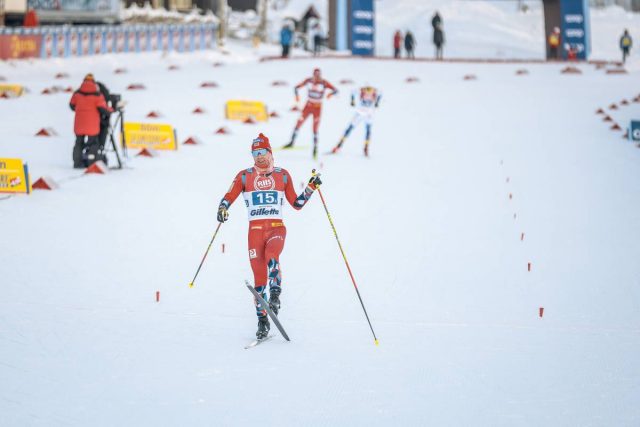
In a clip to FIS media after the race, Norway II skier Mikael Gunnulfsen summed up the result eloquently: “I guess the second team got to the finish line first.”
During a weekend when some Norwegians expressed concern over not meeting the lofty standards of Norwegian skiing on their home turf, the final day saw a result in which Norway II beat Norway I, and the whole country came away with a win. If team relay events are indeed a sign of a national program’s health, then the Norwegians depart Beitostolen secure in the knowledge that their national program still sets the bar in cross-country skiing.
But that conclusion was not clear for large swaths of the race leading to it. In the early going, it was Finland which dictated the dynamic of the pack. Johanna Matintalo (FIN I) kept things controlled alongside Anne Kjersti Kalvaa (NOR I) as the first classic leg wound around the Beitostolen course for lap one. Julia Kern was tucked in the pack for USA I, skiing relaxed even as Matintalo pushed the pace heading up the A-climb. By the time skiers came into the first exchange, Matintalo and Kalvaa had opened a slight gap of around five seconds for Finland and Norway, with the chase group having strung out to two distinct packs. The chase group that came into the stadium first was led by Sweden I, while the second contained Kern at around 12 seconds back. Kern handed off to Wonders for USA I.
Wonders quickly closed the gap as a chase group formed behind Martin Loewstroem Nyenget (NOR I) and Pertuu Hyvarinen (FIN I), who remained off the front. Nyenget looked to increase the pace, but in each little window, Hyvarinen was able to bring his ski tips right back to the Norwegian’s tails. William Poromaa for Sweden I took charge of the chase group headed into the leg’s second lap, right as Nygenet started to stride away from Hyvarinen on the A-climb. Hyvarinen was soon swallowed up by the chase group, but Nygenet faded too. The result: after much Classic sound and fury, the relay field was back together as it headed into the second exchange for the skate portion of the race. Wonders skied a strong leg to cap his weekend, having held 10th place in the pack for USA I.
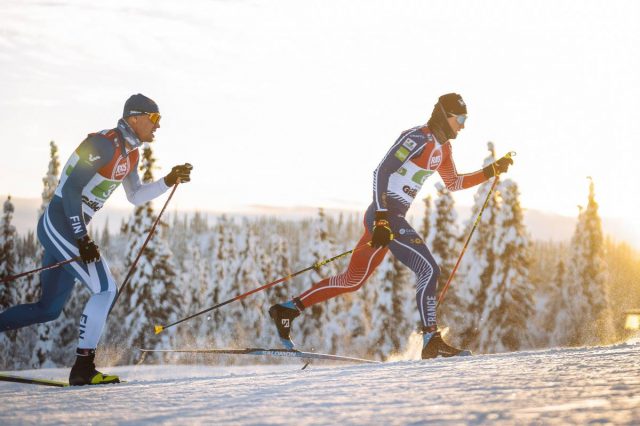
The race continued into the first skate leg, with moves instigated by Sweden I skier Frida Karlsson, who moved to the front of the pack as the course turned upwards, driving an increased pace which slowly diminished the field’s size. Soon, there was a definitive lead group: Karlsson alongside Heidi Weng for Norway I, Silje Theodorsen for Norway II, and Flora Dolci for France I. As they entered the second 2.5 k loop of the leg, Karlsson eased up. In that instant, one skier from the chase group—Finland I’s Kertuu Niskanen—skated to join up with the leaders, in a moment that knowledgable onlookers might have met with a confused “Who put a Niskanen on the skate leg?” Even so, Niskanen’s strong move seemed to validate that decision, her technical prowess and experience showing through no matter what kind of skis she attached to her boots.
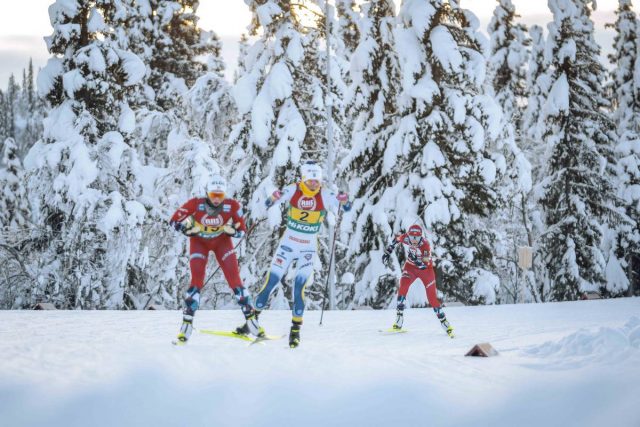
Karlsson slowly turned the pace up through the second lap, and France I’s Dolci eventually faltered, leaving Sweden I, Norway I, Norway II, and Finland I in the race for the podium entering the final exchange. Sophia Laukli kept the US in 10th through her skate leg, minimizing the gap to the leaders to 43 seconds as other teams saw it blow wide open.
Skating in the anchor leg, Finland’s Joni Maki finally broke, and Halfvarsson for Sweden I, Iversen for Norway I, and Krueger for Norway II skied together for a lap. Little jaunts and jukes from all three lead back to stalemate until, on the final lap, one jaunt turned into a jolt, and Krueger pulled away. The field filled in behind, with the Norwegians adding an extra team on the podium, seemingly for emphasis. USA I finished 10th on the day with Ogden skiing the anchor leg.

Pushing Forward, and Up, to Davos
The World Cup circuit’s frantic hop around the Scandinavian peninsula in the past three weeks now gives way towards the Alps as teams travel to Davos, Switzerland. In the run-up to those events, eyes and ears will turn toward news of who will be racing there, including the potential return of Johannes Hoesflot Klaebo, Iivo Niskanen, and Federico Pellegrino. Davos will feature a skate sprint and 20 k individual start skate race.
Ben Ogden says that the US camp is coming off today feeling “excited and motivated headed to Davos,” adding that personally he “needs a few more restful days, but I’m excited for the sprint and to get back to the land of the sun!”
The team will be bolstered by the return of Diggins and Brennan, and with Matt Whitcomb saying Davos is a chance to, “end period I with some high notes. [Diggins and Brennan] both have a great shot to be on the podium in both races next week, so we want to be as prepared as we can for that.”
With the snow-draped trees and soft light present on course—and no World Cup points up for grabs—Sunday’s World Cup mixed relay was a relaxed affair centered around ski racing for the sake of ski racing. Even on its highest level, ski racing remains joyful and keen, like the edge that sharpens itself for the work yet to come.
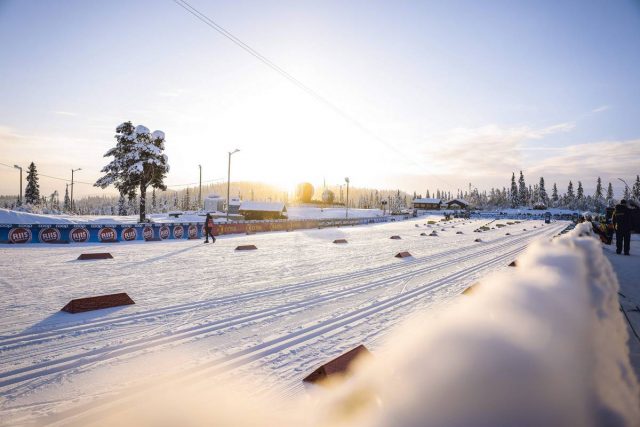
Ben Theyerl
Ben Theyerl was born into a family now three-generations into nordic ski racing in the US. He grew up skiing for Chippewa Valley Nordic in his native Eau Claire, Wisconsin, before spending four years racing for Colby College in Maine. He currently mixes writing and skiing while based out of Crested Butte, CO, where he coaches the best group of high schoolers one could hope to find.



